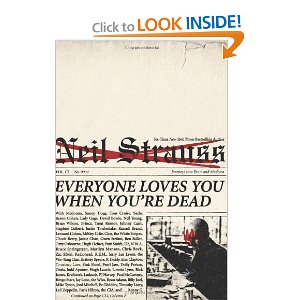
It Books
Everybody Loves You When You’re Dead could have been one continuous cockerel crow of “You should’ve been there; I was” – but it’s not.
It is author Neil Strauss’ job – and has been for a couple of decades – to interview the good, the bad, and the ugly of the world of music, film, and art. If doing the job means mid-afternoon shots of tequila and beers with Bruce Springsteen in a Manhattan bar, well, so be it. If doing the job means giving Snoop Dogg a ride to get Pampers in a dented rental car while Snoop chain-smokes “bomb-ass range weed from my homeboy Chopper,” well, so be it, too. And if doing the job means talking to Calabrian Mafia members on their home turf in Italy about the sometimes-grisly folk music of the area (where violating some very specific ground rules during the interview could result in, um, misfortune), well … you get it.
In choosing material for Everybody Loves You When You’re Dead, Strauss avoided the moments that garnered the most accolades in the pages of publications such as Rolling Stone, Esquire, and The New York Times – and it makes for a good read. This is not the news-breaking headline stuff; rather, it’s the honest-and-real, humans-talking-to-humans stuff.
Sometimes it’s inspirational: Johnny Cash speaks of having almost died during bypass surgery in 1988 and, having looked death in the eye, has no worries about the end. “I didn’t know it was going to be that beautiful. I mean, it’s indescribably beautiful, whatever there is at the end of this life” (which, for Cash, was 2003). And John Hartford, knowing he doesn’t have long to live, chooses to burrow up in making music. When asked about promoting his then-new record, Hartford replies, “I don’t think I’ll be touring this time. I’ve probably only got two years left, and promoting a record is a lot less important to me than having a hell of a time with what I’ve got left.” (As it turned out, Hartford lost movement in his hands shortly after that interview – which meant he was unable to play anymore. He passed away a few months later.)
Sometimes it’s painful: Brian Wilson, who still comes off sharper than Britney Spears.
And sometimes it’s just plain weird: Strauss manages to fake his way into a phone conversation with a guy who made a career out of illegally impersonating bassist Bootsy Collins; has a conversation with Marilyn Manson in a hotel Jacuzzi; gets threatened with a beating by Dolly Parton; and is imprisoned in Courtney Love’s loft for three days.
Strauss breaks the book into ten “acts” comprising many “scenes” – usually a reference to another person or a certain topic in one interview vignette leads to the next and so on. The reality is, it’s Strauss and his ability to have a solid conversation with everyone from Merle Haggard to Ike Turner that’s the real glue.
Even the book’s index makes for entertaining reading – although that’s the only purpose it serves. Don’t be trying to look up any subjects’ names to put your finger on a quote, because you won’t find them listed. What you will find, however, are entries for such items as:
flour, dangers of, 448
balloon animal enthusiasts, 246, 328
Hanson hater websites, 389
wigs, 488; see also toupee
probably funnier if you were there, 338
readers who are frustrated by this useless index, see Xanax
The point of which – if you’d managed to get to the end of Everybody Loves You When You’re Dead without having already figured it out – is that Neil Strauss is as amused and bemused by himself as he is any of his more entertaining and bizarre subjects.
Luckily for us, he takes the art of the interview very seriously.



No Comments comments associated with this post